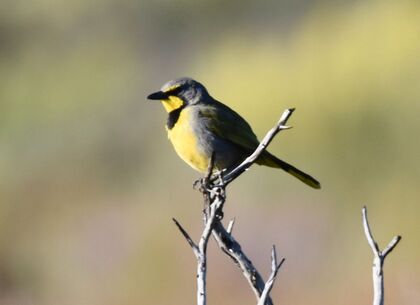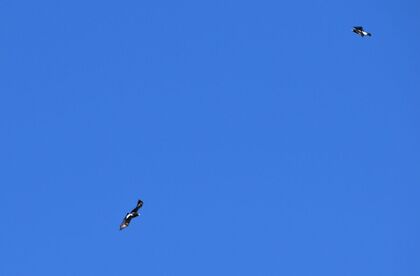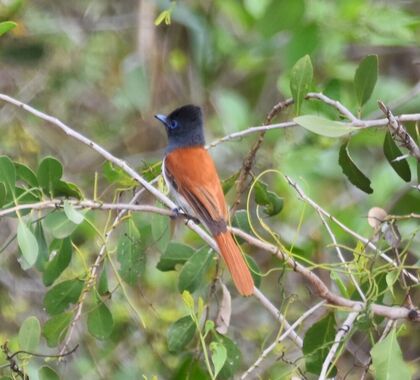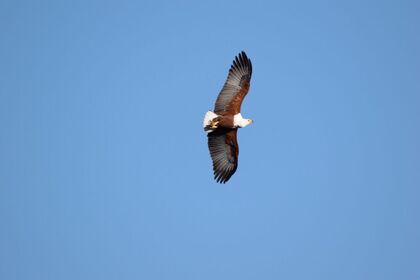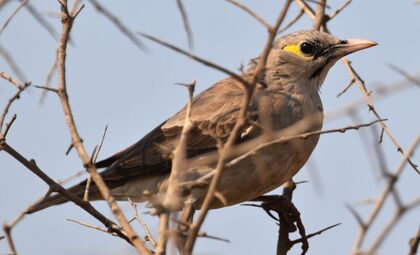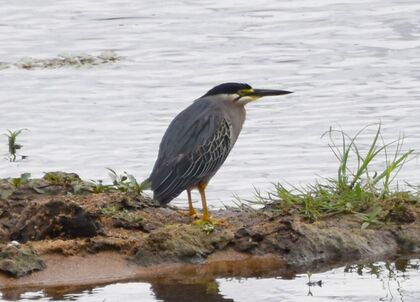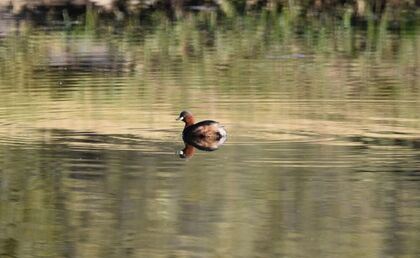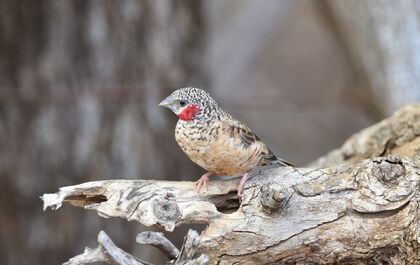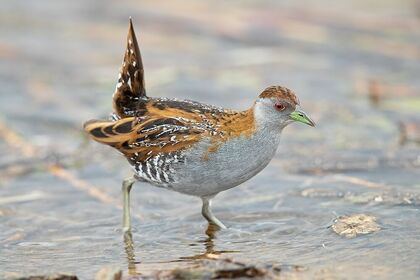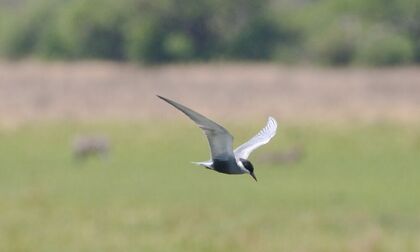
Find the Best Birding Spots in Gauteng
When one thinks of great Birding destinations in sunny South Africa, the economic powerhouse province of Gauteng probably isn't the first place that comes to mind. The province is landlocked between its larger neighbours and is far smaller than the other provinces, only making up 1.5 percent of the total landmass of the country.
But, despite its small size, a quarter of the people in South Africa call Gauteng home - so while Gauteng may not have the most birds in South Africa, it certainly has the most Birders.

Gauteng's Highveld Grasslands
Birds to See
Gauteng may be a small province, but it must be said that it is still very diverse. Various different habitats can be found each less than an hour away from each other, where different species of birds can be found. From woodlands to grasslands, mountains to wetlands, even the human-planted 'forests' within the cities - each contain a different range of habitat specialists than can be explored by the diligent birder.
All of this means that you can find a surprising number of different birds in Gauteng. In fact, the "Birding Big Day'' from 2021 reported 383 species in a single day within the borders of Gauteng Province.
And these aren't just the easy so-called "Trash" birds that live in the city. Extremely special birds such as the Red-chested Flufftail, African Crake, African Grass Owl, Half-Collared Kingfisher and Ovambo Sparrowhawk can all be found in Gauteng - some even in suburban parks within the big cities.
To learn more about the most common birds you can find in Gauteng, check out our guide on the Garden Birds of Gauteng.

Half-collared Kingfisher
Johannesburg
The city of gold is South Africa's most populous metropolitan area. It spans a total of 1700 square kilometers which is mostly developed land, but the area is still chock-a-block full of birds. While the area was previously a natural highveld grassland, the introduction of suburban gardens with a huge number of indigenous trees has meant that the tree-loving birds have been moving in, for example, the Grey Go-Away-Bird is now one of the most common birds in the area.
Some areas still have very large gardens, and a huge number of public and private parks, golf courses and recreation areas provide ample habitat for the birds. So despite humanity's best efforts of changing the natural environment the birds have found a way to co-exist with us. Here are some of the best places to visit while birdwatching in Johannesburg.
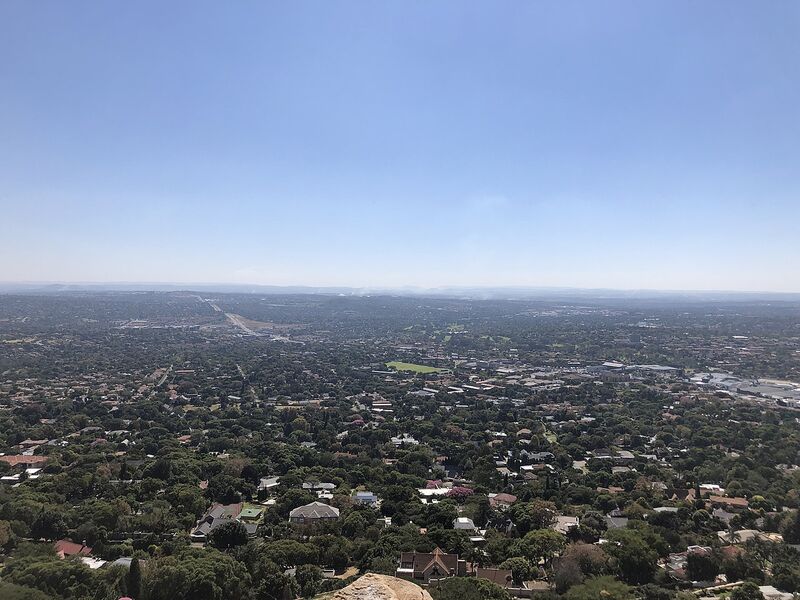
View of Johannesburg's leafy northern suburbs
Delta Park
Delta Park has long been known as one of the best spots for birding in Johannesburg, and incorporates the Florence Bloom bird sanctuary. A number of research projects have been conducted at Delta Park, in particular relating to suburban raptors, and the park is known for the nesting pairs Ovambo Sparrowhawk, Little Sparrowhawk, Spotted Eagle Owl and Common Buzzard.
The huge grass lawns in Delta park give ample space for various lapwings, including the African Wattled Lapwing and Spotted Thick-knees. Helmeted Guineafowls are abundant along with many species of seed-eating weavers, canaries, waxbills and bishops.
A river runs through Delta park and the bird sanctuary itself contains a body of water which often plays home to waders such as the Black-headed Heron, Sacred Ibis, Striated Heron, and Malachite Kingfisher, Pied Kingfisher and Brown-hooded Kingfisher.
Delta Park is a free-to-visit family-friendly birding location and is perfect for bringing the kids for a picnic, a date for a stroll in nature, or a group of friends for one of the many events that are organised and run from Delta Park.
Klipriviersberg
Klipriviersberg is the largest proclaimed nature reserve in the Johannesburg Metropolitan area and is surprisingly unknown for its birding potential. It is free to enter and features a web of hiking trails and is ideal for birding on foot in this unique bio-diverse zone.
Along the river which runs through Klipriviersberg are woodland hills which contain a wide variety of bird species including the White-fronted Bee-eater, Jameson’s Firefinch, Black-crowned Tchagra and Bokmakierie.
If you are willing to climb up the slopes to the top of the hills, you will find one of the best zones for highveld montane grasslands anywhere - excellent bird species here include the Zitting, Wing-Snapping and Cloud Cisticola, African Pipit and Rufous-naped Lark.
Klipriviersberg also features a number of mammals which you can encounter while hiking the area - Blue Duiker, Hartebees, Zebra, Meerkat, Yellow Mongoose, Cape Fox, are amongst the many species that can be found.
Rietfontein Nature Reserve
Located in the affluent Northern Suburbs of Johannesburg, Rietfontein Nature reserve is a hidden gem for birdwatchers in the area. As a mostly grassland and woodland nature reserve with a rocky ridge to hike to - and only a stone’s-throw from the Lonehill Koppie and Dam, Rietfontein Nature reserve includes a surprisingly large variety of bird species that exist in all of these habitats.
The reserve is free to visit and includes a relatively short hike up to the top of the ridge, where wonderful views can be obtained. Along this walk, you can encounter many species including the White-bellied and Amethyst Sunbird, Bar-throated Apalis, Jameson’s firefinch, and Red-throated Wryneck.
At the top of the ridge, you might be lucky enough to run into rock-loving species such as the Cape Rock-Thrush, Familiar Chat and Rock Martin. We have also encountered a number of raptors in the reserve, including the Black Sparrowhawk, Little Sparrowhawk, Gabar Goshawk and Spotted Eagle-Owl.
The close proximity to Lonehill dam also means you can commonly catch large waterbirds flying overhead. Black-headed and Grey Herons are common along with Cattle Egrets and Little Egrets. You might even be lucky enough to catch a Goliath Heron which sometimes visits the Dam. Definitely worth the morning out if you live in the area.



Walter Sisulu National Botanical Gardens
One of the most esteemed Botanical Gardens in the country, the Walter Sisulu Botanical Gardens are an incredible place to visit for any nature-lover. Although a small entrance fee needs to be paid to enter, this is well worth it for one of the premier birding locations in Johannesburg.
For birding, the Botanical Gardens are famous for their pair of Verreaux’s Eagles that nest on the cliff faces. These birds have been tracked for years and keep coming back and having babies - truly spectacular inside the bounds of Johannesburg.
The list of birds to find at the Botanical Gardens is too long for this article, but some highlights are the Peregrine Falcon, African Paradise Flycatcher, Diederik Cuckoo, Fairy Flycatcher, Southern Boubou, and even the very rare Grey Wagtail!
Other than birding, the botanical gardens are one of the top locations to bring the family for a day out. Picnicking is hugely popular as well as taking a walk to the famous waterfall and up to the top of cliff faces for a spectacular view of Johannesburg.
Pretoria
Only an hour North of Johannesburg, do we find South Africa’s capital city - Pretoria.
Pretoria is located at the boundary between the highveld grasslands in the south and the Bushveld to the north. As such it contains varieties of species from both of these habitats. The city hosts numerous Nature Reserves, parks and open spaces all offering ample birding opportunities within the city.

View of Pretoria
Rietvlei Nature Reserve
Rietvlei Nature Reserve is a large nature reserve built around the Rietvlei dam in South-east Pretoria. The nature reserve is highly popular for birdwatchers and nature lovers and features a network of roads that can be explored by car (no unguided walks can be done as the reserve contains 2 of the big-5 - White Rhino and Buffalo, as well as Cheetah).
Rietvlei also features a total of 6 separate bird hides! These hides are mostly located over water, but a couple also sit over the grasslands and 1 features a beautiful panorama of the nature reserve.
Over 300 birds have been sighted in this reserve and some common specials include the Crimson-breasted Shrike, Little Bittern, White-breasted Cormorant, Cuckoo-Finch, Banded Martin, Green Sandpiper and Buffy Pipit.
Raptors can also be commonly found in the park including a nesting pair of Black-Chested Snake Eagles, Fish Eagles, Long-Crested Eagle and Peregrine Falcon.
Roodeplaat Dam Nature Reserve
Roodeplaat Dam Nature reserve is another nature reserve around a dam in the North-east of Pretoria. The dam is a popular location for holiday-goers, where fishing, hiking and boating are all common.
The dam is a hotspot for all of your water-birds and waders and a variety of Kingfishers, Herons and Egrets can be found including the Giant Kingfisher, Goliath Heron, Striated Heron, Little Egret and Egyptian Goose. Fish Eagles and Little Sparrowhaks patrol the skies while European Bee-eaters call in their flocks overhead (in the summer months).
The nature reserve also allows birders to take a walk/drive around and see a wide range of bushveld birdlife. This includes a large group of Wattled Starlings, Kurrichane Thrush, Crimson-breasted Shrike and the Sabota Lark.
Austin Roberts Bird Sanctuary
If you have been birding in South Africa, you are almost certain to know about Austin Roberts. The most widely used bird book and bird app are named after this great Ornithologist, as is this Bird Sanctuary located in the middle of Pretoria City.
The sanctuary is a surprising hotspot for Wetland birds in the middle of the city with two streams running into the sanctuary’s wetland. A hide is built in the middle of the sanctuary to allow birders to view the various birds including a range of Cormorants, Ducks, Geese, Ibises, Kingfishers, Moorhens, Coots, Grebes, Cranes and more.
The reserve also features a delightful small restaurant named after South Africa’s national bird - The Blue Crane Restaurant. These guys make some wonderful food including excellent milkshakes, making the sanctuary a lovely day out for the whole family.
Dinokeng
Up in the far northern tip of Gauteng, features the province's largest big 5 game reserve, Dinokeng. This reserve is massive and still fairly new (opened in only 2011) and features a variety of woodland habitats, and the various species that occupy them.
The reserve has a substantial entrance fee, and as such, it is recommended to stay a night or two at one of the many lodges, resorts or campsites available. The roads are very rugged and at least a full day is required to fully explore the various hides, picnic sites and landmarks in the expansive park.
Being so far North, Dinokeng offers some birds that are difficult to see elsewhere in the province such as the Greencapped Eremomela, Tinkling Cisticola, Pallid Flycatcher, Southern Pied Babbler, Great Spotted Cuckoo, Monotonous Lark, Red-backed Shrike, Cut-throat Finch and Woodland Kingfisher.
Raptors are also aplenty in such a large protected area. These include the African Fish Eagle, Lesser Kestrel, African Cuckoo-Hawk, Black-chested Snake Eagle and Lizard Buzzard.
Abe Bailey Nature Reserve (Carletonville)
The far west corners of the province are known more for their mining and industry than their birds. These areas are not regularly visited by tourists, which is a shame because you get a different set of interesting species in this dry dusty grassland landscape.
If you are willing to take the drive out, Abe Bailey Nature Reserve near Carletonville is a special birding location. The reserve features a number of bodies of water where your typical waterbirds can be found including the Greater Flamingo, Black Crake, Red-billed Teal, Little Bittern and African Swamphen. You can also commonly run into the South African Shelduck whose range has only recently included this area.
Other dry grassland birds that can be found here are the Red-headed Finch, African, Buffy and Plain-backed pipit, Chestnut-Backed Sparrow-Lark and Northern Black Korhaan.
The Vaal
In the Southern End of Gauteng we find a completely different habitat - the Vaal Marina. South Africa’s second largest dam is naturally a wetland birding paradise.
These wetland birds are home to a huge range of Ducks, Geese, Teals and Kingfishers - and also some more rare water birds such as the Greater Flamingo, South-African Shelduck, Baillon’s Crake, Caspian Tern and African Marsh-Harrier.
The area around the Vaal also consists of grasslands full of special highveld grassland birds including the African Grass-Owl, Orange-river Francolin, Pink-billed Lark, Pale-crowned Cisticola and Blue Korhaan.
The Vaal area also offers a unique opportunity to birdwatch from a boat. This gives a different perspective of the birds which are often not as shy as they are when approaching them on foot. Our recommendation is to rent a small house-boat (various companies offer this at an affordable price) that you can drive yourself and sleep a night on the river and catch the birds on the waterfront first thing in the morning.
Marievale
If this list was ranked in order of our favourites, Marievale would top the list. This bird sanctuary in the South East of Gauteng has almost achieved a cult status amongst birders in the province. And rightly so. A massive portion of the sanctuary are floodplains and is one of the best places to see many wetland specials in the entire country.
Marievale features a handful of well-maintained bird hides, and a picnic site/braai area to have brunch. These hides sit over some of the many wetlands which play host to huge numbers of waterbirds including Reed Cormorants, Moorhens, Red-knobbed Coots, Pied Avocet and Yellow-billed Ducks. Rare heron populations consist of Goliath, Black, Squacco and Purple Herons.
Some of the more special water birds that you can find are Marsh Owl, Red-chested Flufftail, Curlew Sandpiper, Sand Martin, Caspian Tern, Baillon’s Crake, Black-winged Pratincole and Black-tailed Godwit.
Although the wetlands are the main attraction of Marievale, the surrounding grasslands are also thronging with birdlife, including Levaillant’s Cisticola, African Grass-Owl, Capped Wheatear, Cape Longclaw, Long-tailed Widowbird, Black-winged Kite and Orange-breasted Waxbill.
Suikerbosrand
The Suikerbosrand region in the South of Gauteng includes the highest lying land area in the province. The similarly named nature reserve is a large reserve famous for its hiking and hilly landscape but is also known amongst birders as a hotspot just off the N1 highway near Heidelberg.
The hilly grassland area can be explored by the long section of roads in the reserve, or on foot via one of the many hiking routes in the area. The grasslands play host to many species such as the African Pipit, Orange-breasted Waxbill, Crowned Lapwing and the notoriously shy African Grass Owl.
The picnic sites in the reserve are some of the best birding spots, where you can easily find Mocking Cliff Chat, Mountain Wheatear, Neddicky, Bar-throated Apalis, Chestnut-vented Warbler, Red-faced Mousebird, Acacia Pied Barbet, Cape White-eye, Streaky-headed Seedeater, and Common Scimitarbill.
Due to its location, Suikerbosrand can be explored on the same day (or same weekend) as Marievale, where an avid birder can possibly sight up over 100 unique species in a single trip.
Ezemvelo Nature Reserve
Another little-knowing birding utopia, Ezemvelo nature reserve is located in the North-East of Gauteng and is one of the best spots for location of many of the highveld grassland specials that are not easy to locate.
The reserve is less than 2 hours away from Johannesburg and Pretoria and is surprisingly well managed for a government-run facility in the middle of nowhere. The lodge provides extremely well priced (and well-maintained) rooms and the hiking trails are legendary for hikers and birders alike.
The grasslands are the main feature of the reserve and you are bound to run into throngs of grassland birds along your trip. These include the Common Ostrich, African Pipit, Buffy Pipit, Eastern Clapper Lark, Rufous Naped Lark, Orange-river Francolin, Shelley’s Francolin, Temminck's Courser, African Quail-Finch and Long-tailed Widowbird.
The areas around the camps also feature some rocky slopes with woodlands which allow you to see a different range of birds including the Arrow-marked Babbler, Little Bee-eater, Crested and Black-collared Barbet, Yellow-fronted Tinkerbird, Cinnamon-breasted Bunting and Greater Honeyguide.
If you stay the night, you will also hear a chorus of nightjars including the Fiery-necked Nightjar, Freckled Nightjar and possibly the Rufous-checked Nightjar. Spotted Eagle-Owls are also commonly seen and heard at night in the reserve.
Magaliesberg
While not strictly in Gauteng, the Magaliesberg and Hartbeespoort region is still a hotspot for Gauteng birders. This mountain range provides a transitionary zone between the grasslands in the south and the bushveld in the north - as well as mountain cliffs and montane woodlands.
The Magaliesberg Skeerpoort cliffs are one of the big attractions and play host to hundreds of Cape Vultures - one of the largest colonies of this large endangered raptor in the world. These vultures are fed through a number of Vulture Restaurants which can be visited by the public - one of them at the renowned Rhino and Lion park in the region.
Other than the vultures, many other species can be found including many specials such as the Purple Indigobird, Little Sparrowhawk, Cuckoo-finch, Amur Falcon and Pearl-spotted Owlet.
In Conclusion
When I started birding, I didn’t consider Gauteng a great birding location but as I learnt the area, the question became less about where good spots were, and rather which spots to choose from! The variety in this small province is really quite astounding.
From grassland to woodland, highveld to bushveld, mountains, rivers, wetlands and suburban gardens - the range of habitats and related species is impressive. So don’t discount these local places when planning your next getaway, Gauteng truly has some of the best birding possibilities in the country.







